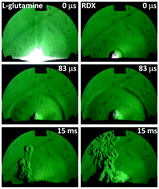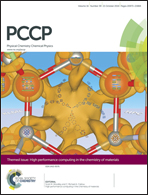Influence of exothermic chemical reactions on laser-induced shock waves
Abstract
Differences in the excitation of non-energetic and energetic residues with a 900 mJ, 6 ns laser pulse (1064 nm) have been investigated. Emission from the laser-induced plasma of energetic materials (e.g. triaminotrinitrobenzene [TATB], cyclotrimethylene trinitramine [RDX], and hexanitrohexaazaisowurtzitane [CL-20]) is significantly reduced compared to non-energetic materials (e.g. sugar, melamine, and L-glutamine). Expansion of the resulting laser-induced shock wave into the air above the sample surface was imaged on a microsecond timescale with a high-speed camera recording multiple frames from each laser shot; the excitation of energetic materials produces larger heat-affected zones in the surrounding atmosphere (facilitating deflagration of particles ejected from the sample surface), results in the formation of additional shock fronts, and generates faster external shock front velocities (>750 m s−1) compared to non-energetic materials (550–600 m s−1). Non-explosive materials that undergo exothermic chemical reactions in air at high temperatures such as ammonium nitrate and magnesium sulfate produce shock velocities which exceed those of the inert materials but are less than those generated by the exothermic reactions of explosive materials (650–700 m s−1). The most powerful explosives produced the highest shock velocities. A comparison to several existing shock models demonstrated that no single model describes the shock propagation for both non-energetic and energetic materials. The influence of the exothermic chemical reactions initiated by the pulsed laser on the velocity of the laser-induced shock waves has thus been demonstrated for the first time.


 Please wait while we load your content...
Please wait while we load your content...